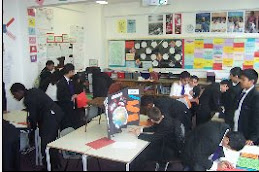Each sheet is printed on A3. Students always respond to 'big paper' so it gives learning more impact. If your school allows it, use coloured paper. It is more relaxing on the eye and students associate the topics with the colours.

But what are the steps?
Step 1 - This part starts with information needed to get the lowest grades. E.g. keyword crosswords, definition matching, short answer concepts, diagram labelling, etc.
Step 2 - incorporates 'middle' difficulty questions in a more complex format. For instance, gap fill exercises, graphic organisers or ranking information.
Step 3 - only has open-ended exam questions with space for answers. Questions should be those that push thinking, e.g. evaluation questions or those starting with "Give reasons for and against..."
Classroom Management
Explain the structure to students and advise them to start where they are comfortable. The only rule is that they must be confident in the first tier before they start the next one. This means they should be able to complete a tier without any help or copying before they move on.
 To support this have extra 'step sheets' ready. E.g. have extra key words challenges, extra gapfills and organisers, and extra open-ended questions all on smaller A5 sheets. If a student fills in Step 1 but it took a long time and a lot of help, then they can complete another Step 1 to gain confidence.
To support this have extra 'step sheets' ready. E.g. have extra key words challenges, extra gapfills and organisers, and extra open-ended questions all on smaller A5 sheets. If a student fills in Step 1 but it took a long time and a lot of help, then they can complete another Step 1 to gain confidence. On the other hand, students who are bright can start at Step 2 (I rarely let them skip to Step 3) and race into Step 3 before repeating as many high-end questions as possible.
In doing so all students see progress, they can start where they feel comfortable and everyone is engaged right from the start :)
